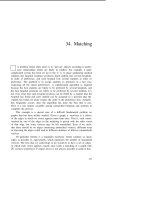Tài liệu Thuật toán Algorithms (Phần 15) pptx
Bạn đang xem bản rút gọn của tài liệu. Xem và tải ngay bản đầy đủ của tài liệu tại đây (74.11 KB, 10 trang )
PRIORITY QUEUES
133
again by exchanging C with the larger of its two sons (in this case S). The
process continues until the heap condition is no longer violated at the node
occupied by C. In the example, C makes it all the way to the bottom of the
heap, leaving:
The “remove the largest” operation involves almost the same process.
Since the heap will be one element smaller after the operation, it is necessary
to decrement leaving no place for the element that was stored in the last
position. But the largest element is to be removed, so the remove operation
amounts to a replace, using the element that was in For example, the
following heap results from removing the T from the heap above:
The implementation of these procedures is centered around the operation
of fixing up a heap which satisfies the heap condition everywhere except
possibly at the root. The same operation can be used to fix up the heap
after the value in any position is lowered. It may be implemented as follows:
134
CHAPTER 11
procedure downheap(k: integer)
label
i, j, v: integer;
begin
v:=a[k];
while N div 2 do
begin
j:=k+k;
if j<N then if then
if then
k:=j;
end;
end
This procedure moves down the heap (starting from position k), exchanging
the node at position j with the larger of its two sons if necessary, stopping when
j is larger than both sons or the bottom is reached. As above, a full exchange
is not needed because v is always involved in the exchanges. The inner loop in
this program is an example of a loop which really has two distinct exits: one
for the case that the bottom of the heap is hit (as in the first example above),
and another for the case that the heap condition is satisfied somewhere in the
interior of the heap.
Now the implementation of the remove operation is simple:
function remove: integer;
begin
N:=N-1;
end ;
The return value is set from then the element from a [N] is put into
and the size of the heap decremented, leaving only a call to to fix
up the heap condition everywhere.
The implementation of the replace operation is only slightly more com-
plicated:
PRIORITY QUEUES
135
function
begin
downheap( ;
end
This code uses a[O] in an artificial way: its sons are 0 (itself) and 1, so if v is
larger than the largest element in the heap, the heap is not touched; otherwise
v is put into the heap and returned..
The delete operation for an arbitrary element from the heap and the
change operation can also be implemented by using a simple combination of
the methods above. For example, if the priority of the element at position k
is raised, then can be called, and if it is lowered then
does the job. On the other hand, the join operation is far more difficult and
seems to require a much more sophisticated data structure.
All of the basic operations insert, remove, replace, and upheup),
delete, and change involve moving along a path between the root and the
tom of the heap, which includes no more than about log N elements for a heap
of size N. Thus the running times of the above programs are logarithmic.
An elegant and efficient sorting method can be defined from the basic opera-
tions on heaps outlined above. This method, called Heapsort, uses no extra
memory and is guaranteed to sort M elements in about Mlog M steps no
matter what the input. Unfortunately, its inner loop is quite a bit longer
than the inner loop of Quicksort, and it is about twice as slow as Quicksort
on the average.
The idea is simply to build a heap containing the elements to be sorted
and then to remove them all in order. In this section, N will continue to be
the size of the heap, so we will use M for the number of elements to be sorted.
One way to sort is to implement the construct operation by doing M insert
operations, as in the first two lines of the following code, then do M remove
operations, putting the element removed into the place just vacated by the
shrinking heap:
for to M do
for k:=M do a[k]:=remove;
136
CHAPTER 11
This code breaks all the rules of abstract data structures by assuming a par-
ticular representation for the priority queue (during each loop, the priority
queue resides in . . . , a[k-1]), but it is reasonable to do this here because
we are implementing a sort, not a priority queue. The priority queue proce-
dures are being used only for descriptive purposes: in an actual implementa-
tion of the sort, we would simply use the code from the procedures to avoid
doing so many unnecessary procedure calls.
It is actually a little better to build the heap by going backwards through
it, making little heaps from the bottom up. Note that every position in the
array is the root of a small heap, and will work equally well for
such small heaps as for the big heap. Also, we’ve noted that remove can be
implemented by exchanging the first and last elements, decrementing and
calling This leads to the following implementation of Heapsort:
procedure heapsort;
var k, integer;
begin
N:=M;
for k:=M div 2 do downheap(
repeat
until =
end
The first two lines of this code constitute an implementation of
integer) to build a heap of M elements. (The keys in a[ (M div each
form heaps of one element, so they trivially satisfy the heap condition and
don’t need to be checked.) It is interesting to note that, though the loops in
this program seem to do very different things, they can be built around the
same fundamental procedure.
The following table shows the contents of each heap operated on by
for our sorting example, just after has made the heap
condition hold everywhere.
PRIORITY QUEUES
137
12345678 9 10 11 12 13 14 15
ASORTINGEXAMPLE
N L E
P M I
X
T A
R G E
P 0 N M I L E
X R T G E S A
XTPRSONGEAAMILE
TSPREONGEAAMIL
SRPLEONGEAAMI
R L P
IEONGEAAM
P L 0
IEMNGEAA
OLNIEMAGEA
NLMIEAAGE
M L E
IEAAG
L
IEGEAA
IGEAEA
G E E A A
E A E A
E A A
A A
A
AAEEGILMNOPRSTX
As mentioned above, the primary reason that is of practical
interest is that the number of steps required to sort M elements is guaranteed
to be proportional to M log M, no matter what the input. Unlike the other
methods that we’ve seen, there is no “worst-case” input that will make
sort run slower. The proof of this is simple: we make about calls to
(about to construct the heap and M for the sort), each of
which examines less than log M heap elements, since the heap never has more
than M elements.
Actually, the above proof uses an overestimate. In fact, it can be proven
that the construction process takes linear time since so many small heaps are
processed. This is not of particular importance to Heapsort, since this time
is still dominated by the M log M time for sorting, but it is important for
other priority queue applications, where a linear time construct can lead to
a linear time algorithm. Note that constructing a heap with M successive
inserts requires M log M steps in the worst case (though it turns out to be
linear on the average).









